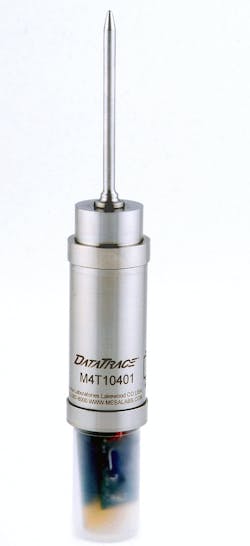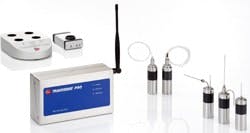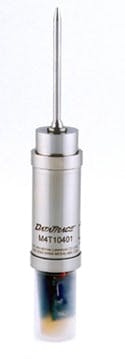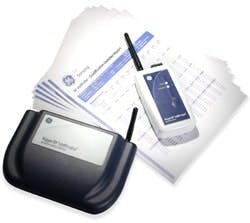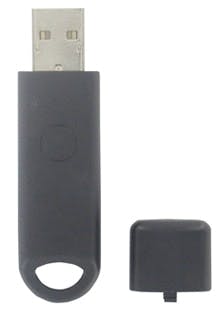Data loggers now seem nearly as pervasive in pharma plants as the data that they monitor and capture. In an environment where electronic sensor and measurement technologies have mushroomed, paper-dependent chart recorders are so last century. Plus, drug manufacturers are hyper-vigilant about process validation, so the need for instruments to capture and preserve data in perpetuity is great.
Pharmaceutical data logging has traditionally been the domain of devices that log and verify temperature readings as well as basic parameters like pressure and relative humidity during process operations. But depending on the process, key parameters such as pH, blend uniformity, liquid levels, equipment vibration, operator activity — you name it — may require constant monitoring and logging.
The modern plant is “well instrumented,” says Chris Felts, DeltaV system product manager for data integration products with Emerson Process Systems. Emerson’s solutions often act as the storage and operator interface points for much of the data measured by these instruments. Is there such a thing as TMI — too much information?
Not really, says Felts. “In the last couple of years, pharmaceutical manufacturers have been focusing on collecting all the data they can,” he says. “As data collection technologies advance and data storage capacities increase, customers believe it’s worth it to get as much information as they can.” In other words, better safe than sorry. “If you miss one important bit of information, you might end up having to throw a whole batch away,” says Felts.
FDA’s recent validation requirements, which leave it up to the manufacturer to determine which data is essential to prove control over their processes, have also been responsible for the current data logging boom, says Harper Howell, president of Ellab, whose products include temperature loggers for autoclaves, lyophilizers, and other harsh process environments. “There’s a fear in the industry that you have to over-document and over-test,” he says. It’s overkill, Howell admits, but he doesn’t see it diminishing any time soon.
Howell says that his company now has four times as many pharmaceutical customers as it did a few years ago, which has as much to do with technology improvements as with customer requirements. Wireless radio technology now makes it possible to, for example, monitor and log temperatures within a lyophilizer in real time. This is an improvement upon wired thermocouples and previous “wireless” logging technologies which could be placed anywhere but could only read after process completion. Real-time, wireless monitoring and capture is the “Holy Grail” for pharmaceutical data logging, Howell says.
Other data logging trends to watch include cheaper devices with more memory, lower power requirements, more rugged batteries and improved communication. Some units combine several functions — for example, sensing, converting sensed signals to digital form, and storing that digital data. Other units are just for storage, but often do so in prodigious amounts.
Loggers with flash memory cards such as those used in digital cameras to store and download data to PCs are increasingly popular — data is collected when the flash card is inserted into the logger. PC-based control and monitoring systems have assumed much of the workload once carried by distributed control systems. Mature data protocols such as OPC have enabled easier communication between sensors, loggers, PCs, data historians and other systems that manage and store critical manufacturing information. Ethernet- and USB-enabled data loggers have also proliferated.
Ellab’s TrackSense Pro Sky
These trends are carried over into facility-critical data capture and logging, too, says Felts: valve diagnostics, motor shaft vibration, current draw, and coolant temperatures. “Anything that will provide information on the health of capital assets will end up on loggers,” he says. “The big payoff is in reduction in downtime.”
With these thoughts in mind, what follows is a look at some of the most recent product offerings in data logging available to the pharmaceutical industry today.
Ellab released the TrackSense Pro Sky data logger, of which Howell speaks, in 2008 and will display the real-time, wireless system at March’s Interphex show in New York. The loggers can view real-time data in validation studies for lyophilizers, autoclaves, stability chambers, and freezers. Depending on the model, the devices cover a temperature range of -80° to 140° C and a transmission range of 50 feet.
Mesa’s DataTrace MPRF temperature logger
Mesa Laboratories offers a variety of temperature, humidity and pressure loggers. The DataTrace MPRF temperature logger also provides real-time and historian data, for temperatures ranging from -80ºC to +400ºC, making it usable for autoclaves, incubators, stability chambers and process establishment and validation.
Kaye’s ValProbe, which connects to a base station
The Kaye RF ValProbe system from GE Sensing integrates RF Mesh technology with thermal validation in-situ loggers. The system is comprised of RF wireless loggers, a base station and software. The loggers provide high accuracy measurement of temperature, humidity and any 4-20 or 0-10V output. The software incorporates features such as self-configuring of the mesh network and automatic data collection.
Veriteq, Inc.’s VL series is made specifically for FDA-regulated environments. These include the VL-2000, for high-accuracy recording of temperature and relative humidity for pharma applications. The device is tamper-proof, with encrypted password-protected records. The VL-1000-VLT is designed for temperatures as low as -86° C. Many of Veriteq’s loggers recently got a design makeover for improved wireless and Ethernet connectivity.
While it still offers old-fashioned chart recorders — such as the VFC70 for vaccine temperature monitoring — Dickson Co. is encouraging manufacturers to transition to digital by offering paperless chart recorders, whose flat panel LCD graphical displays match or exceed those of paper charts in clarity and function. All of Dickson’s paperless recorders feature audit trail and encrypted data via the company’s Secure software to meet 21 CFR Part 11 requirements.
Dwyer’s DW-USB-LITE, a mini temp logger
Dwyer Instruments’ DW-USB series data loggers monitor temperature, humidity, dew point, voltage or current. Users can choose sampling rate, start time, high/low alarm settings and temperature unit parameters with Windows-based software. Stored data is downloaded by plugging the module into a PC’s USB port.
Looking for multifunctionality? Logic Beach, Inc. offers “hyper loggers” that, in addition to data acquisition, can output alarms, transfer data back to a central location, email status reports or serve Web pages with embedded values. Pharma plants might consider the HyperLogger PowerPlus, which can perform energy audits in addition to logging power, temperature, pressure, etc.
Hobo loggers (some stainless) made by Onset Computer Corp. measure 18 parameters, including temperature, humidity, voltage, current, watts, pressure, carbon dioxide, light intensity and vibration. Onset’s data loggers are connected to a PC for initial configuration, and reconnected later for downloading stored data.
Omega’s OM-CP-CRYO-TEMP ultra low temperature data logger records temperatures as low as -122ºF (-86ºC), making it useful for monitoring blood plasma, vaccines and other temperature-sensitive drugs. The device has an optional USB docking station, and time-stamped data can be viewed in graphs or tables.
MadgeTech, Inc. makes a variety of specialized loggers, including the recent PRHTemp2000 for pressure, humidity and temperature. Its LCD digital display shows the current readings, as well as battery level, external power status, sampling and recording status. The company also recently released Secure Software for 21 CFR Part 11 compliance. The software incorporates electronic signatures, access codes, secure data file and audit trail.
Telatemp’s Transit Thermometer is designed to help certify the quality of drugs during shipment. The disposable thermometer records elapsed time vs. temperature with NIST-traceable accuracy up to ±1ºF. The system is tamperproof in that, once started by the shipper, it cannot be stopped or reset.
Fluke’s 1735 power logger
For those into power, Fluke’s portable 1735 Power Logger conducts load studies to comply with National Electrical Code (NEC) 220.87, energy assessments and general power quality logging — capturing up to 45 days of data. Maybe best of all, it needs no batteries or external power.
